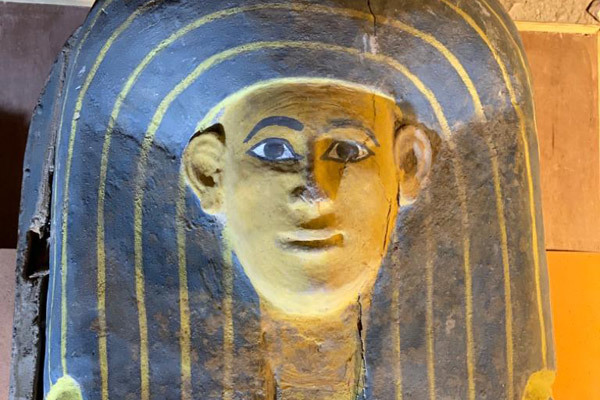- Egypt: A pharaonic tomb with 18 doors and 450 square meters, the new Luxor find
- Excavation: in the footsteps of the guardians of southern Egypt
Three pharaonic coffins with colorful decorations and hieroglyphic inscriptions have appeared buried in an unexpected place. An unusual finding, on the ground of a sacred road, that a French mission has just signed in the confines of the ancient Thebes, the current Luxor.
"Our work reveals for the first time an unknown funerary practice, burial under the sacred pavement ," Frédéric Colin, professor of Egyptology at the University of Strasbourg and director of the joint mission of the French Institute of Eastern Archeology, tells EL MUNDO.
"The hypothesis is that the position under that road was a precious place because the processions of the god Amun passed just above these tombs during the great celebrations, in which the necropolis and the temples of Deir el Bahari were visited," adds the expert.
Colin considers it probable that this burial model was found a century ago by the first archaeological missions that excavated the Hatshepsut road, "but, really, they did not understand" its peculiarity. "From the anthropological point of view, it is an unrecognized funeral practice , possibly because there were no methods to document the results of the excavation at the beginning of the 20th century."
Only now the Gallic project has managed to draw up a report of a funeral practice that affected burials that were exhumed from a previous location and that could even go through a collective burial before finding rest under the street. "The decision to re-bury these deceased had to be taken in an opportunistic manner during the construction of the road," Colin slides.
The position in which they found eternal rest was privileged, under the road that led the pilgrims from the alluvial plain of the Nile to the temple of Thutmose III, the construction that, for more than a decade, excavates the Spanish archeologist Myriam Seco in the western shore of Luxor , about 600 kilometers south of Cairo.
Labyrinthine Tomb of the Scribe
The three sarcophagi were found buried in a very thick earth movement belonging to the construction of a conserved soil in the outer courtyard of the labyrinthine tomb of the royal scribe Pediamenopet TT33), the largest burial of a courtier in the Asasif necropolis. " That this tomb has remained intact is a miracle because it escaped into the deep trench dug in the seventh century BC to install the Pylon of Pediamenopet," admits Colin.
Researchers who have worked on the finding place the three coffins in the 18th dynasty of the New Kingdom, some 800 years before the burial of the scribe. Made of wood and well preserved, the sarcophagi housed two women -Rau and Ta-abu- and a man whose name is unknown. Ta-abu's is 195 centimeters long. The third coffin, which exhibits a beard, is 180 centimeters.
"They call attention to the quality of their preservation and their relative rarity. Some similar models were found in the first half of the twentieth century, but they are scarce," Colin advances. The identity of the finite continues to be unknown . "The status of the deceased is precisely one of the issues that our next investigation will have to solve. They were probably people of intermediate level, with wealth but without occupying the top of the social hierarchy," he concludes.
According to the criteria of The Trust Project
Know more- science
- Science and Health
Climate crisis Brazil will ask for funds to preserve the Amazon at the Madrid Climate Summit
ScienceGreta Thunberg, chosen by Nature magazine as one of the 10 relevant people in science in 2019
ScienceA piece of prehistoric chewing gum reveals its consumer's DNA

